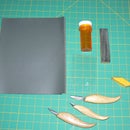Introduction: How to Carve an Ocarina Out of Wood
In this instructable you will learn how to carve and ocarina out of wood!
From Wikipedia:
The ocarina. Variations do exist, but a typical ocarina is an enclosed space with four to twelve finger holes and a mouthpiece that projects from the body. It is often ceramic, but other materials may also be used, such as plastic, wood, glass, clay, and metal.
Ok Audio sample uploaded at Utube
http://www.youtube.com/watch?v=sJwVPP3ErdY
Attachments
Step 1: Tools an Materials
Materials required: 4" X 1 3/4" X 1 1/4" block of wood ( I used bass wood)
4" X 1 3/4" X 1/8" sheet of wood ( I used bass wood)
glue
Tools required : pen, pencil, steel ruler, 1/4" chisel, small carving chisel, small skewed chisel
various small files, 150 sand paper, 220 sand paper, drill bits or a unibit
Optional tools and materials : carving knifes, gouges, and wood burner, Kiwik-wood for repairs
Step 2: Making Marks on the Block
Start by marking the long sides of the wood block with your pencil or pen for 1/8" in.
You can use the sheet that will become the top of the ocarina to do this.
Next use your steel ruler to mark one end 5/8" in this is where the airway will go.
On the other end make the end 5/32" in.
Next on the 5/8" side mark a 1/2" wide channel, this will be your airway.
I have marked it with red stripes for clarity.
Step 3: Start Carving the Chamber
(BEFORE YOU DO ANY CARVING TAKE EXTREME CARE, CARVING TOOLS ARE SHARP
AND WILL GIVE YOU A NASTY GASH, NOT JUST A CUT. RESPECT SHARP TOOLS ! )
Begin carving the inside of the ocarina by scoring the lines with red arrows pointing to them with the
chisel facing out. (As a side note; if you have a router you could probably rout out the inside.)
Again using the chisel start digging out the inside by working the chisel to the score mark.
As you carve up to the edge continually score it to keep the walls as clean as possible.
Stop part of the way down and cut the airway .Carve slivers at a time and Finnish it with a file.
Some notes on the air way it is shaped like a ramp, and starts big and end small with the width remaining the same.
The air way at the end that you blow should be about 2/32" and the end that is part of the cavity should be about 1/32".
Ok set this part aside and for now and get the sheet that will be the top of the ocarina out.
Step 4: Making the Fipple
This next part is important, it is called the window or fipple.It's what makes the sound.
Draw a line 5/8" in across the width. On this line draw a rectangle about 1//2" X 1/4" indicated by the red.
using the 1/2" chisel ,small chisel and the small skewed chisel cut the square out and clean it with a small file.
Once you Finnish cutting out the rectangle draw a second rectangle behind it about 1/2" long indicated by the blue.
Use the 1/2" chisel and (or) the small chisel to carve out a ramp. This ramp should look like the end of your 1/2" chisel.
I have included a picture of a cross section so there is no doubt as to what this part should look like.
just a couple of minor details make a small angle on the bottom as indicated by the red and sand
flat sand the entire bottom with 220 sandpaper.
At this point put the two parts together and blow, you should be hearing a tone!
And no you don't need to glue it yet, just press the two parts together.
Step 5: Remove More Material Until You Get a C Note
now go to the online tuner. http://www.seventhstring.com/tuner/tuner.html
Now blow and look at the note that is displayed. In my particular instance it's an F5.
Music notes go like CDEFGABC . Since we want the Ocarina to be a C we will need to
remove more material until we get a C, which will likely be a C5.
with the little blue arrow at the bottom as close to "0" as possible.
If you a get a funny little "b" that is flat or a pound symbol "#" that is a sharp.
(for the purposes of this instructable and for those who don't know about music)
While trying to get a "C" if you get a a flat (funny little "b") the tone is on the low side . If its a sharp (pound #) the tone is on the high side.
If it's sharp remove material. If it's a flat and you removed too much material you can put some back by putting small pieces of wood in the chamber, but you probably won't need to.
I have included a fingering chart. the black dots are the holes you cover to get the note.
Step 6:
Making the tuning holes
this part is complicated.
A little more on music so bear with me.
(for the purposes of the instructable)
music notes start with a C, then D,E,F,G,A,B and the next C up.
This is called an octave (8 notes).
If you did everything correctly you should be getting a C5 on the tuner which is
one octave above middle C (C4, middle C is the middle C key in a keyboard)
Thing to keep in mind while drilling your tuning holes, start with a small hole and increase the size until you hit the desired note.
The holes are #1 top right, #2 bottom right, #3 top left, and #4 bottom left.
their placement isn't too critical
Start with the #1 hole and start small and keep going up in size till you hit a D note.Remember to clean the holes with 150 sandpaper after drilling.
Then continue with hole #2. To tune #2 you have to cover #1 (the one we just made) keep going to you hit an E note.
(you get an F by leaving 1& 2 open incase you were wondering)
Now the #3 hole. To tune the #3 hole you must cover the #2 hole and leave the #1 open until you get a G
For the 4th and final hole you can cover hole #1 and tune for B or leave them all open and tune for a C.
If the last note doesn't seem to work try blowing softly.
Once your done tuning it. Glue the top on and carve out a mouth piece to make it comfortable to blow on.
Step 7: Finnish and Play!!
That's it!!!! Your done!
If you like you can spray paint it, stain it, carve it, burn it , and or urathane it.
Here are some sites that contain ocarina tablature ( sometimes called fake music).
It shows you where to put your fingers to play a song.
http://composer.songbirdocarina.com/songbook.asp?letter=a
http://clayz.com/songlist.html

Participated in the
3rd Epilog Challenge














